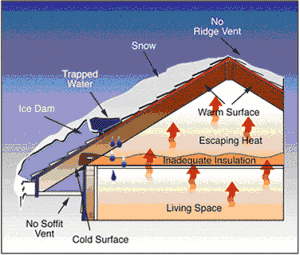If your home feels drafty, or extra chilly even when the heat is on, this is a sign that your home may be experiencing heat loss. However, there are also some heat loss red flags that may not be as glaringly clear.
First, let’s discuss exactly what heat loss is, and how it can negatively affect your home, and your wallet. A heat loss equation can also be a good tool to measure this issue.
Heat loss is defined as a measure of the total transfer of heat through the fabric of a building. From the inside to the outside of your structure, either from conduction, convection, radiation, or any combination of the three. And in winter there is no worse time to

Heat Flow In Your Home
Heat loss from a home can cause a few serious and frustrating problems. Here are some of the more obvious ones:
- High energy bills – If your home is not properly insulated and/or is drafty, your bill will be much higher. With poor insulation and a very drafty home, the inside can feel cold regardless of how high the heat is. This is especially true on very cold days. This means that to feel comfortable, you will likely be continuously increasing the heat. Another way to spot heat loss is if your interior walls, floors, or ceilings feel cold to the touch. This is a clear indication that your home lacks proper insulation.
- Ice dams on your roof or gutters – Ice dams occur on your roof’s edge and/or on your gutter system as a direct result of heat loss from your attic/roof. As the heat escapes from your roof it melts the snow and ice that sits on top of it. When this melted ice/snow slides down your roof to its edge and/or your gutter system that is still cold, it refreezes. This will result in ice dams. While many people may believe that this is a sign of a gutter problem, it often isn’t. Having a heat loss test performed is a great first step to remedy this. Follow that by adding insulation, and then installing a heated gutter system.
- Frozen pipes – If your pipes are frozen in your wall this means that you have an insulation problem. Frozen pipes are a very serious issue that could lead to large damages like flooding and mold if they were to burst.
- Fluctuating temperatures – If a home is insulated properly, the temperature should remain fairly consistent. If you feel like the temperatures are constantly changing in your home, or that one or two rooms are always colder than others, you are likely experiencing heat loss.
Heat Loss In Your Home
In addition to the more apparent signs of heat loss listed above, there are other less noticeable things to look for when testing your home for heat leakage.
- Skylights – Skylights allow beautiful natural light to stream into your home. However, they also add an additional place for heat to escape. A home with a skylight will typically lose 35-45 percent more heat during the winter months. Since heat rises, when the warm air comes into contact with the cold surface of the window, the air cools and circulates down. This results in what feels like a draft and the loss of heat.
- Areas where venting exists – This is usually in a bathroom with a shower, the room with the a dryer vent, or in a kitchen near the stove fan. These fans are meant to rid moist warm air from your home. This will help to avoid rotting, condensation, mold, etc. While these fans are designed to avoid letting in the cold air, they are not air tight. This results in inevitable loss of heat in these areas.
- Bay windows – Since bay windows are so large, they often have issues with losing heat. Windows are one of the biggest air leakage culprits, and bay windows are notorious for being difficult to insulate because of their size, shape, and design.
- Visible rafter or truss lines – If you can see the spacing of the rafters/trusses after snow, this is an indication that you have uneven temperatures on your roof line. Rising heat in the attic comes through the plywood easier than where the rafters are located. A pattern of lines on your roof will occur when it snows. Some areas will be melt, while others will remain with snow.
Let The Pros Help
Heat loss can be a result of different things in your home. Having proper insulation and sealing of windows, chimneys, doors, vents, etc. can go a long way. This help in reducing the amount of heat your home is losing, and thus decrease your high energy bills. Issues like ice dams, and frozen pipes can not only cause annoying drafts and pricey bills, but they can also lead to serious and costly damages like flooding that can lead to mold and moisture buildup. Once you’ve had your insulation evaluated, combining insulation upgrades with a heated gutter system makes for a perfect team in eliminating damaging ice damming. Contact The Brothers that just do Gutters today for your free estimate on a heated gutter system!

